Page 104 of 680
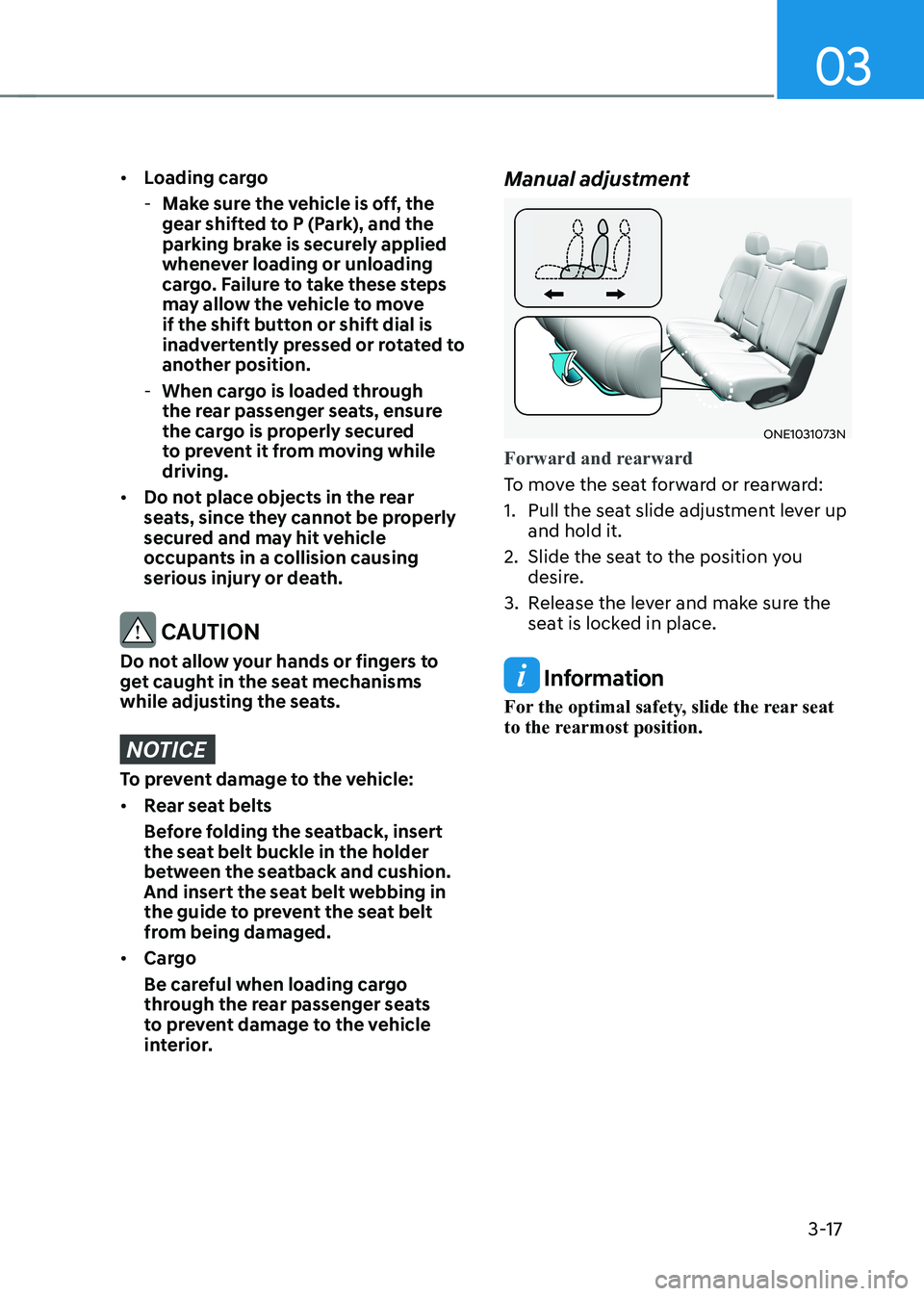
03
3-17
• Loading cargo
- Make sure the vehicle is off, the
gear shifted to P (Park), and the
parking brake is securely applied
whenever loading or unloading
cargo. Failure to take these steps
may allow the vehicle to move
if the shift button or shift dial is
inadvertently pressed or rotated to
another position.
- When cargo is loaded through
the rear passenger seats, ensure
the cargo is properly secured
to prevent it from moving while driving.
• Do not place objects in the rear
seats, since they cannot be properly
secured and may hit vehicle
occupants in a collision causing
serious injury or death.
CAUTION
Do not allow your hands or fingers to
get caught in the seat mechanisms
while adjusting the seats.
NOTICE
To prevent damage to the vehicle: • Rear seat belts
Before folding the seatback, insert
the seat belt buckle in the holder
between the seatback and cushion.
And insert the seat belt webbing in
the guide to prevent the seat belt
from being damaged.
• Cargo
Be careful when loading cargo
through the rear passenger seats
to prevent damage to the vehicle
interior. Manual adjustment
ONE1031073N
Forward and rearward
To move the seat forward or rearward:
1. Pull the seat slide adjustment lever up
and hold it.
2. Slide the seat to the position you desire.
3. Release the lever and make sure the seat is locked in place.
Information
For the optimal safety, slide the rear seat
to the rearmost position.
Page 105 of 680
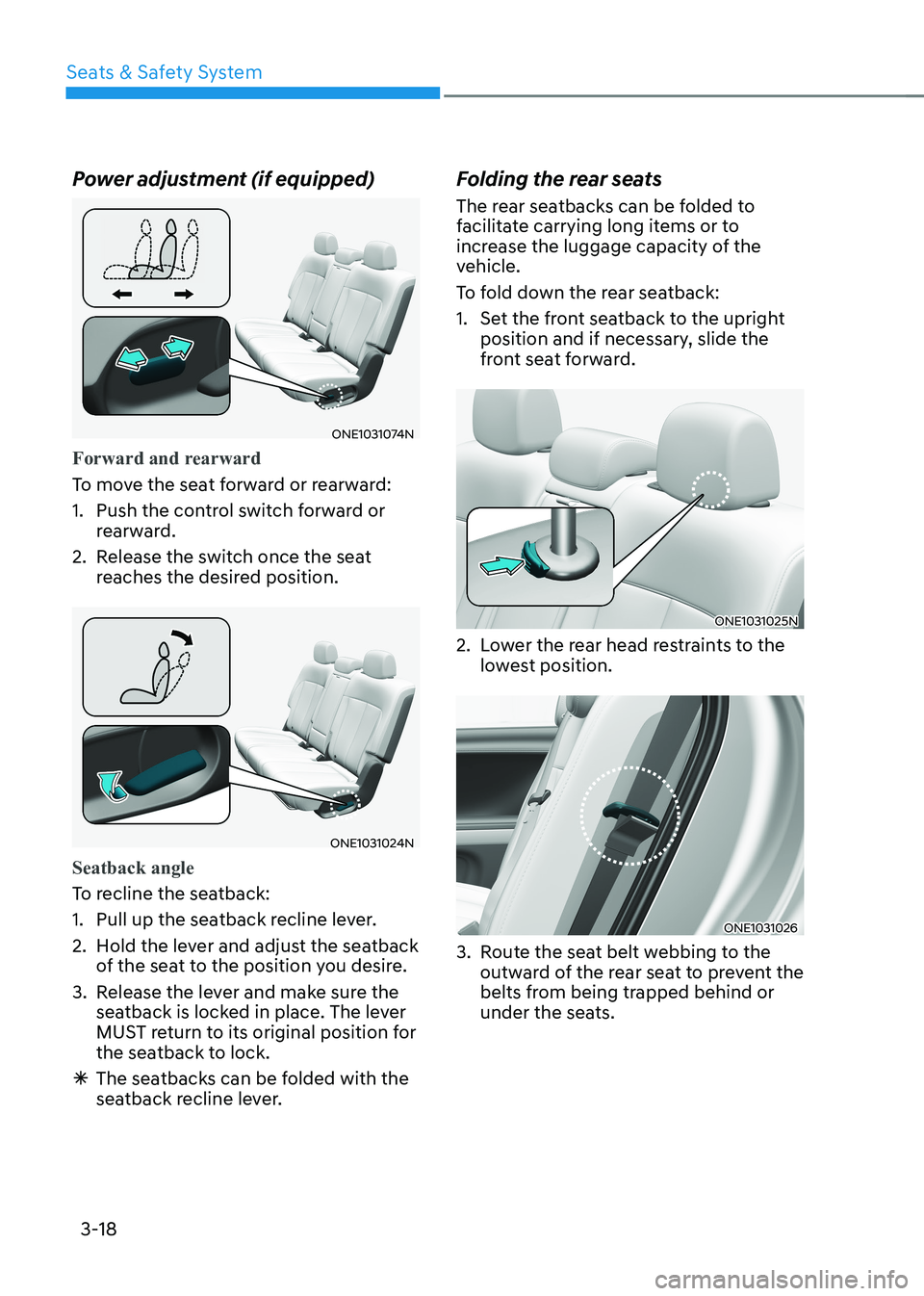
Seats & Safety System
3-18
Power adjustment (if equipped)
ONE1031074N
Forward and rearward
To move the seat forward or rearward:
1. Push the control switch forward or
rearward.
2. Release the switch once the seat reaches the desired position.
ONE1031024N
Seatback angle
To recline the seatback:
1. Pull up the seatback recline lever.
2. Hold the lever and adjust the seatback
of the seat to the position you desire.
3. Release the lever and make sure the seatback is locked in place. The lever
MUST return to its original position for
the seatback to lock.
à The seatbacks can be folded with the
seatback recline lever. Folding the rear seats
The rear seatbacks can be folded to
facilitate carrying long items or to
increase the luggage capacity of the
vehicle.
To fold down the rear seatback:
1. Set the front seatback to the upright
position and if necessary, slide the
front seat forward.
ONE1031025N
2. Lower the rear head restraints to the lowest position.
ONE1031026
3. Route the seat belt webbing to the outward of the rear seat to prevent the
belts from being trapped behind or
under the seats.
Page 106 of 680
03
3-19
ONE1031027N
4. Pull up the seatback folding lever
(1), then fold the seat (2) toward the
front of the vehicle. When you return
the seatback to its upright position,
always be sure it has locked into
position by pushing on the top of the
seatback.
ONE1031028N
5. To use the rear seat, lift and unfold the seatback (2) to the upright position
by pulling up the folding lever (1).
Push the seatback firmly until it clicks
into place. Make sure the seatback is
locked in place.
6. Return the rear seat belt to the proper position. Armrest
ONE1031031N
The armrest is located in the center of
the rear seat. Pull the armrest down from
the seatback to use it.
CAUTION
The armrest handle may be pressed
when folding the rear seatback, but it
will be restored after a certain period of time.
Page 107 of 680
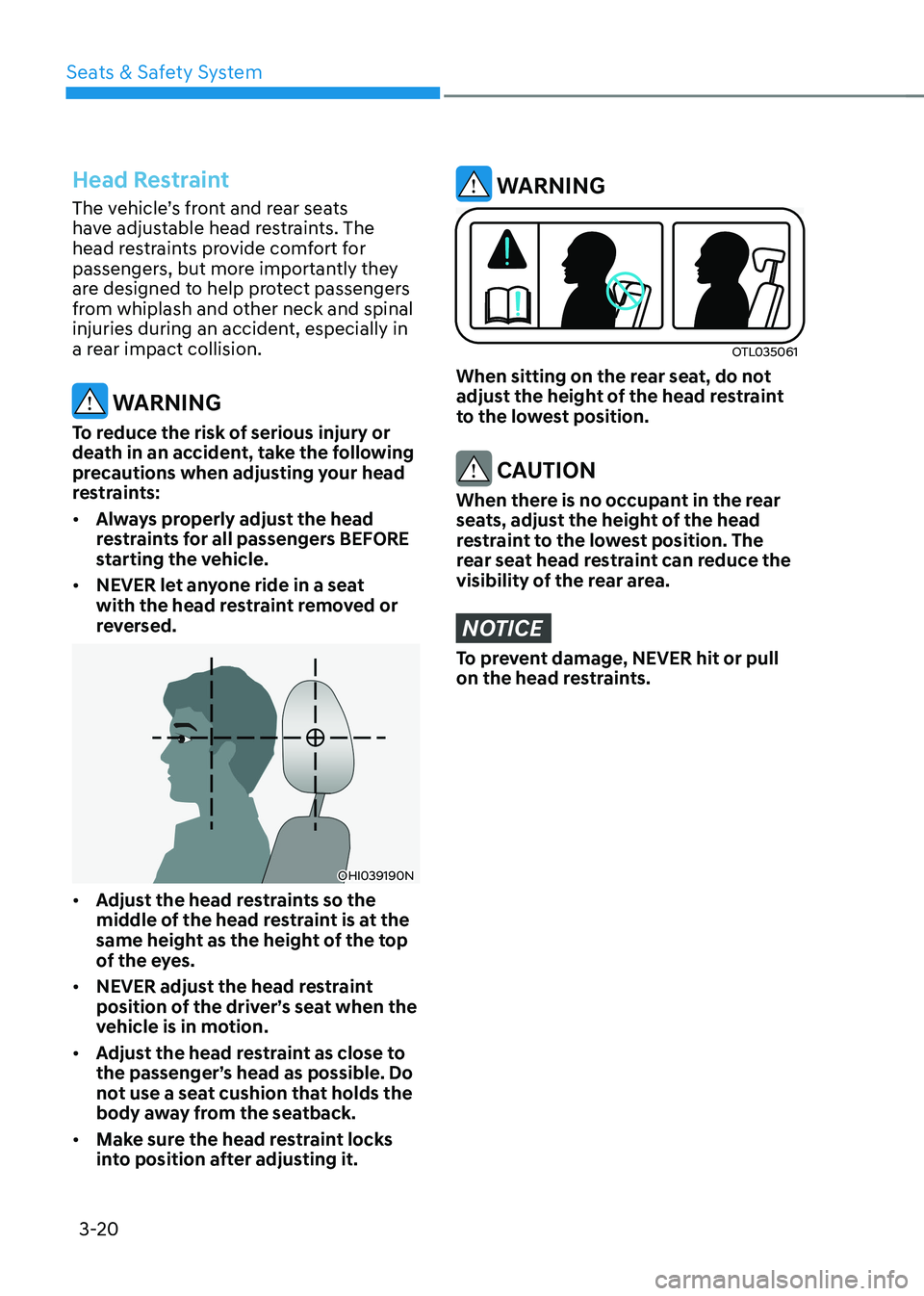
Seats & Safety System
3-20
Head Restraint
The vehicle’s front and rear seats
have adjustable head restraints. The
head restraints provide comfort for
passengers, but more importantly they
are designed to help protect passengers
from whiplash and other neck and spinal
injuries during an accident, especially in
a rear impact collision.
WARNING
To reduce the risk of serious injury or
death in an accident, take the following
precautions when adjusting your head
restraints: • Always properly adjust the head
restraints for all passengers BEFORE
starting the vehicle.
• NEVER let anyone ride in a seat
with the head restraint removed or
reversed.
OHI039190N
• Adjust the head restraints so the
middle of the head restraint is at the
same height as the height of the top
of the eyes.
• NEVER adjust the head restraint
position of the driver’s seat when the
vehicle is in motion.
• Adjust the head restraint as close to
the passenger’s head as possible. Do
not use a seat cushion that holds the
body away from the seatback.
• Make sure the head restraint locks
into position after adjusting it.
WARNING
OTL035061
When sitting on the rear seat, do not
adjust the height of the head restraint
to the lowest position.
CAUTION
When there is no occupant in the rear
seats, adjust the height of the head
restraint to the lowest position. The
rear seat head restraint can reduce the
visibility of the rear area.
NOTICE
To prevent damage, NEVER hit or pull
on the head restraints.
Page 110 of 680
03
3-23
Rear seat head restraints
ONE1031029
The rear seats are equipped with head
restraints in all the seating positions for
the passenger’s safety and comfort.
ONE1031030N
Adjusting the height up and down
To raise the head restraint:
1. Pull it up to the desired position (1).
To lower the head restraint:
1. Push and hold the release button (2) on the head restraint support.
2. Lower the head restraint to the desired position (3).
ONE1031083N
Removal/Reinstallation
To remove the head restraint:
1. Raise the head restraint as far as it can go.
2. Press the head restraint release button (1) while pulling the head restraint up (2).
To reinstall the head restraint:
1. Put the head restraint poles into the holes (3) while pressing the release
button (1).
2. Adjust the head restraint to the appropriate height.
Page 115 of 680

Seats & Safety System
3-28
Advanced Rear Occupant Alert
(ROA) (if equipped)
Advanced Rear Occupant Alert is
provided to help prevent a driver from
leaving a vehicle with the rear passenger
left in the vehicle.
System setting
To use Rear Occupant Alert, it must be
enabled from the Settings menu in the
infotainment system screen. Select: - Setup � Vehicle Settings �
Convenience � Rear Occupant Alert
(ROA)
For detailed information, refer to the
separately supplied infotainment
system manual.
System operation • First alert
When you turn off the vehicle and
open the driver’s door after opening
and closing the rear door or liftgate,
the ‘Check rear seats’ warning
message appears on the cluster.
WARNING
Even if your vehicle is equipped with
Advanced Rear Occupant Alert (ROA),
always make sure to check the rear seat
before you leave the vehicle.
Advanced Rear Occupant Alert (ROA)
may not operate when: • Movement does not continue for
a certain period of time or the
movement is small.
• A child is not seated in a child
restraint system.
• Movement is detected in areas other
than the rear seats.
• The rear passenger is covered with a
fabric containing metallic substance
such as a blanket.
• An object in the vehicle blocks the
sensor.
• The sensor is contaminated by
foreign material.
• An animal at the rear seat or luggage
compartment is not large enough to
be detected by the sensor or there is
hardly any movement.
• Attaching objects or modifying the
interior ceiling, or the interior ceiling
is deformed or damaged.
• There are electronic interference
around the vehicle.
• Other environmental reasons that
may affect the system.
Page 116 of 680
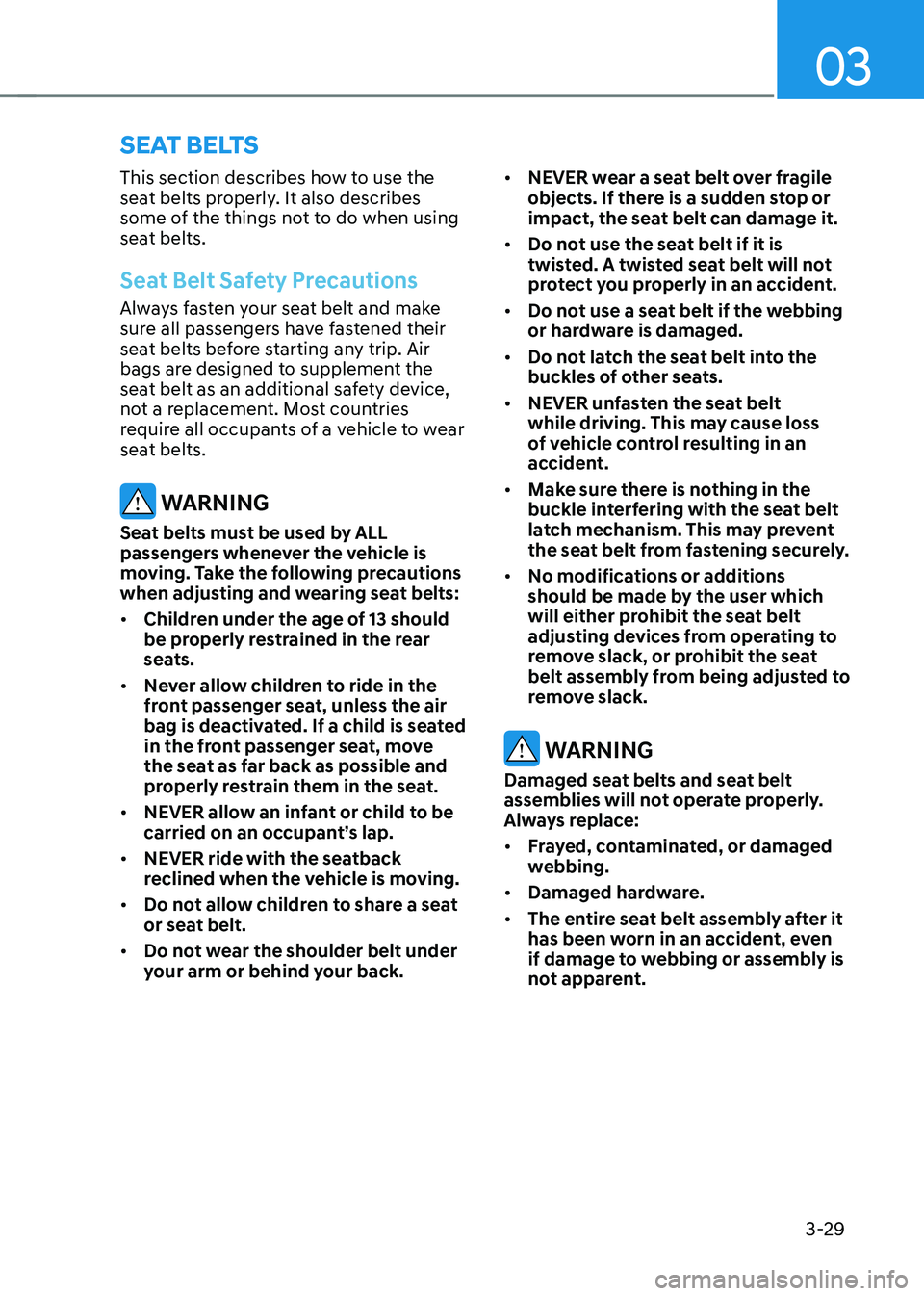
03
3-29
seat belts
This section describes how to use the
seat belts properly. It also describes
some of the things not to do when using
seat belts.
Seat Belt Safety Precautions
Always fasten your seat belt and make
sure all passengers have fastened their
seat belts before starting any trip. Air
bags are designed to supplement the
seat belt as an additional safety device,
not a replacement. Most countries
require all occupants of a vehicle to wear
seat belts.
WARNING
Seat belts must be used by ALL
passengers whenever the vehicle is
moving. Take the following precautions
when adjusting and wearing seat belts: • Children under the age of 13 should
be properly restrained in the rear
seats.
• Never allow children to ride in the
front passenger seat, unless the air
bag is deactivated. If a child is seated
in the front passenger seat, move
the seat as far back as possible and
properly restrain them in the seat.
• NEVER allow an infant or child to be
carried on an occupant’s lap.
• NEVER ride with the seatback
reclined when the vehicle is moving.
• Do not allow children to share a seat
or seat belt.
• Do not wear the shoulder belt under
your arm or behind your back. •
NEVER wear a seat belt over fragile
objects. If there is a sudden stop or
impact, the seat belt can damage it.
• Do not use the seat belt if it is
twisted. A twisted seat belt will not
protect you properly in an accident.
• Do not use a seat belt if the webbing
or hardware is damaged.
• Do not latch the seat belt into the
buckles of other seats.
• NEVER unfasten the seat belt
while driving. This may cause loss
of vehicle control resulting in an
accident.
• Make sure there is nothing in the
buckle interfering with the seat belt
latch mechanism. This may prevent
the seat belt from fastening securely.
• No modifications or additions
should be made by the user which
will either prohibit the seat belt
adjusting devices from operating to
remove slack, or prohibit the seat
belt assembly from being adjusted to
remove slack.
WARNING
Damaged seat belts and seat belt
assemblies will not operate properly.
Always replace: • Frayed, contaminated, or damaged
webbing.
• Damaged hardware.
• The entire seat belt assembly after it
has been worn in an accident, even
if damage to webbing or assembly is
not apparent.
Page 120 of 680
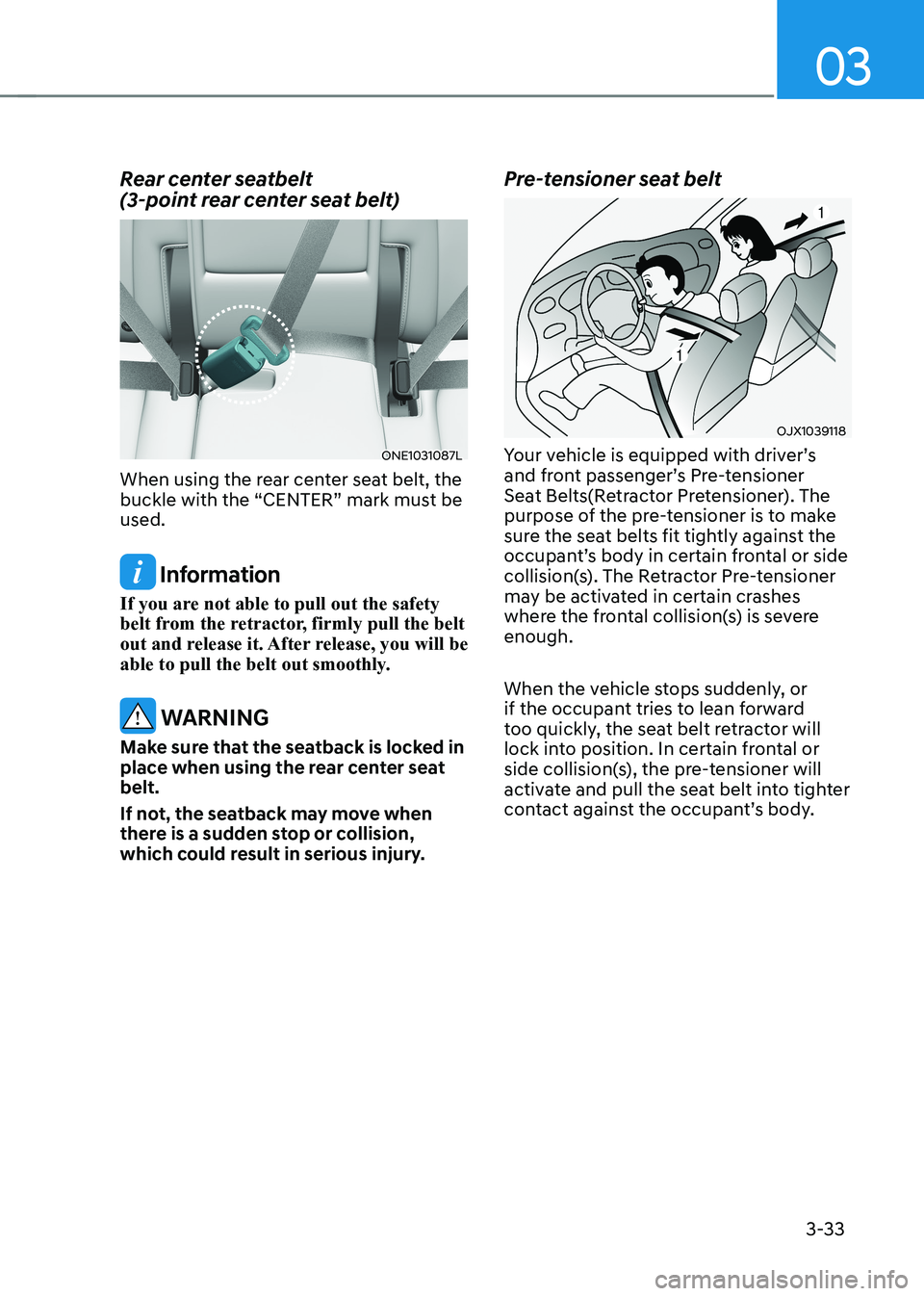
03
3-33
Rear center seatbelt
(3-point rear center seat belt)
ONE1031087L
When using the rear center seat belt, the
buckle with the “CENTER” mark must be used.
Information
If you are not able to pull out the safety
belt from the retractor, firmly pull the belt
out and release it. After release, you will be
able to pull the belt out smoothly.
WARNING
Make sure that the seatback is locked in
place when using the rear center seat belt.
If not, the seatback may move when
there is a sudden stop or collision,
which could result in serious injury. Pre-tensioner seat belt
OJX1039118
Your vehicle is equipped with driver’s
and front passenger’s Pre-tensioner
Seat Belts(Retractor Pretensioner). The
purpose of the pre-tensioner is to make
sure the seat belts fit tightly against the
occupant’s body in certain frontal or side
collision(s). The Retractor Pre-tensioner
may be activated in certain crashes
where the frontal collision(s) is severe enough.
When the vehicle stops suddenly, or
if the occupant tries to lean forward
too quickly, the seat belt retractor will
lock into position. In certain frontal or
side collision(s), the pre-tensioner will
activate and pull the seat belt into tighter
contact against the occupant’s body.